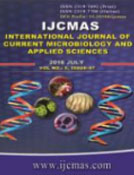


 National Academy of Agricultural Sciences (NAAS)
National Academy of Agricultural Sciences (NAAS)

|
PRINT ISSN : 2319-7692
Online ISSN : 2319-7706 Issues : 12 per year Publisher : Excellent Publishers Email : editorijcmas@gmail.com / submit@ijcmas.com Editor-in-chief: Dr.M.Prakash Index Copernicus ICV 2018: 95.39 NAAS RATING 2020: 5.38 |
The main aim of this study was to evaluate the antibacterial activity of aqueous extracts, chloroform extracts and methanol extracts obtained from leaves, bark and roots of Moringa oleifera (Lam) against four food borne microbial pathogens, Salmonella enteritica, Vibrio parahaemolyticus, Escherichia coli and Listeria monocytogenes. In general, extracts obtained by all extraction methods showed antimicrobial activity against all tested microorganisms. Lowest and highest antibacterial activity was shown by aqueous extraction and chloroform extraction of residue obtained after aqueous extraction. Highest antibacterial activity was shown by chloroform extraction of residue obtained after aqueous extraction against Salmonella enteritica. Listeria monocytogenes was found to be the most resistant organism to all types of extracts. Higher antibacterial activity was shown against gram negative bacteria compared to gram positive bacteria tested. According to the results of the study, chloroform extraction was found to be the best extraction method to extract antimicrobial compounds from Moringa oleifera (Lam). Bark of the plant shown to be containing higher amount of antimicrobial compounds compared to leaves and roots of the pant. In conclusion, Moringa oleifera (Lam) extracts found to be containing chemical compounds useful in food preservation and development of drugs against food borne microbial pathogens.
 |
 |
 |
 |
 |